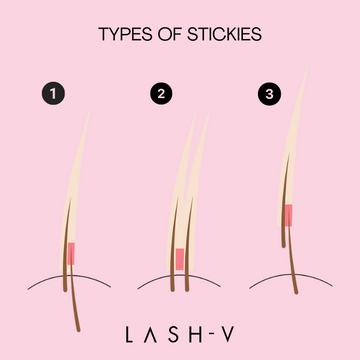Different types of stickies

The first type of stickie is when a tiny baby lash gets stuck to an extension. These are one of the most common, and one of the most damaging types of stickies.


Finally, the third type of stickie is when 2 natural lashes are stuck together. This can happen when you have placed an extension on a natural lash but have taken it off again, either due to bad positioning or too much glue. The natural lash is still covered in glue and can easily adhere to the neighbouring lash when you come to re-isolate the surrounding lashes. These are the ones you have to watch out for because they are very easy to miss!
Stickies are extremely damaging to the natural lash. So how do you prevent them?
The initial measure to ward off stickies is precise lash isolation. Nevertheless, despite your carefulness, occasional stickies may still arise, underscoring the importance of post-application inspection.
Ensure you apply the appropriate amount of glue—a minute bead, not an excessive blob. Excessively slow-drying adhesives can exacerbate stickies.

Image: Healthy lash growth
How to check your work
Inspecting for stickies is just as crucial as placing eyepatches during your lash procedure; it's all about ensuring safety! Allocate a dedicated 10 minutes at the conclusion of each treatment session to conduct this examination meticulously and accurately. To begin, meticulously scrutinize each lash from its root to its tip using tweezers, ensuring no two baby lashes are stuck together. Additionally, examine the layers of lashes, as they typically don't grow uniformly in a single row; there's a high probability of discovering at least one sticky lash nestled between layers!






